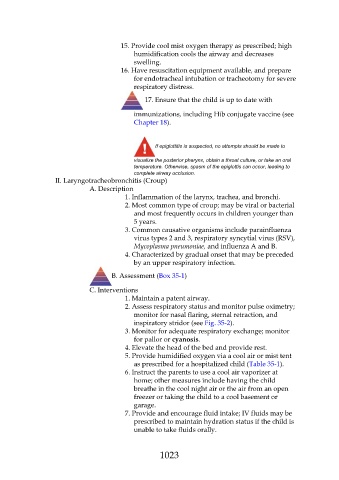Page 1023 - Saunders Comprehensive Review For NCLEX-RN
P. 1023
15. Provide cool mist oxygen therapy as prescribed; high
humidification cools the airway and decreases
swelling.
16. Have resuscitation equipment available, and prepare
for endotracheal intubation or tracheotomy for severe
respiratory distress.
17. Ensure that the child is up to date with
immunizations, including Hib conjugate vaccine (see
Chapter 18).
If epiglottitis is suspected, no attempts should be made to
visualize the posterior pharynx, obtain a throat culture, or take an oral
temperature. Otherwise, spasm of the epiglottis can occur, leading to
complete airway occlusion.
II. Laryngotracheobronchitis (Croup)
A. Description
1. Inflammation of the larynx, trachea, and bronchi.
2. Most common type of croup; may be viral or bacterial
and most frequently occurs in children younger than
5 years.
3. Common causative organisms include parainfluenza
virus types 2 and 3, respiratory syncytial virus (RSV),
Mycoplasma pneumoniae, and influenza A and B.
4. Characterized by gradual onset that may be preceded
by an upper respiratory infection.
B. Assessment (Box 35-1)
C. Interventions
1. Maintain a patent airway.
2. Assess respiratory status and monitor pulse oximetry;
monitor for nasal flaring, sternal retraction, and
inspiratory stridor (see Fig. 35-2).
3. Monitor for adequate respiratory exchange; monitor
for pallor or cyanosis.
4. Elevate the head of the bed and provide rest.
5. Provide humidified oxygen via a cool air or mist tent
as prescribed for a hospitalized child (Table 35-1).
6. Instruct the parents to use a cool air vaporizer at
home; other measures include having the child
breathe in the cool night air or the air from an open
freezer or taking the child to a cool basement or
garage.
7. Provide and encourage fluid intake; IV fluids may be
prescribed to maintain hydration status if the child is
unable to take fluids orally.
1023

